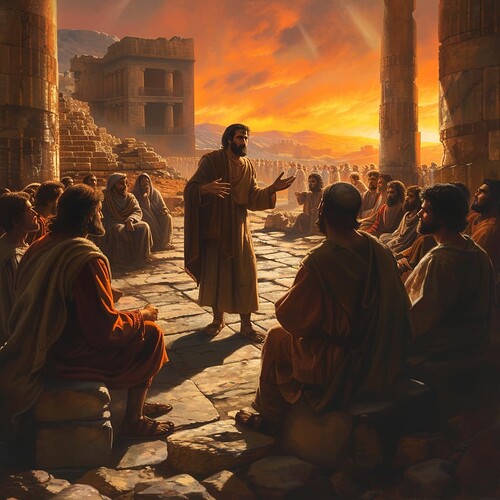![]() February 17: Mark 13 - Countdown to the End Times
February 17: Mark 13 - Countdown to the End Times
#![]() Introduction
Introduction
Mark 13 takes us into the Midst of Christ’s teachings on the Mount of Olives, presenting an intricate apocalyptic vision that intertwines the fall of Jerusalem and the end times. This discourse, often referred to as “The Little Apocalypse,” serves as a pivotal guide for believers through tumultuous times.
#![]() Jesus Foretell’s Destruction of the Temple
Jesus Foretell’s Destruction of the Temple
Prompted by the disciples’ admiration for the Temple’s magnificence, Jesus prophecies its destruction, symbolizing the end of the Old Covenant system (Mark 13:1-2).
![]() Key Verse:
Key Verse:
“And Jesus said to him, ‘Do you see these great buildings? Not one stone will be left here upon another; all will be thrown down.’”- Mark 13:2.
#![]() The Olivet Discourse: Warnings, Signs, and Exhortations
The Olivet Discourse: Warnings, Signs, and Exhortations
Jesus delineates the hardships to come- deceiving false Christs, wars, natural calamities, and heightened persecution. He encourages vigilance, insisting that these trials are “birth pains”, precursors to the glorious Second Coming (Mark 13:5-37).
![]() Key Verse:
Key Verse:
“But about that day or hour no one knows, neither the angels in heaven, nor the Son, but only the Father.” – Mark 13:32
#![]() Key Themes and Reflections
Key Themes and Reflections
-
Alert Living: Jesus emphasizes repeatedly the need for watchfulness. It’s a call for Christians today to live with intentionality, discernment, and constant readiness for Christ’s coming.
-
Divine Sovereignty: Despite the trials to come, Christ’s tone is not of panic but of certainty. It reassures us of God’s firm control over all future events.
#![]() Today’s Application
Today’s Application
In our unpredictable world, let’s anchor our faith not in temporal structures but in Christ, our Eternal Rock. Live each day with Kingdom mindfulness, discerning truth from deception, embodying love amidst divisiveness, focusing on the ‘permanent’ amidst the ‘temporary.’
#![]() Hidden Gem
Hidden Gem
The word “watch” appears four times in this discourse, indicating the importance of spiritual vigilance in the Christian journey.
#![]() Reflective Q&A:
Reflective Q&A:
![]() Why does Jesus emphasize unknowable timing regarding His return?
Why does Jesus emphasize unknowable timing regarding His return?
A: To discourage date-setting and to foster a perpetual state of readiness among believers.
![]() How can we apply Jesus’s teachings from Mark 13 to our daily lives?
How can we apply Jesus’s teachings from Mark 13 to our daily lives?
A: By living out our faith attentively, discerning world events through a Biblical lens, and acting as ambassadors of hope in a groaning world.
#![]() Join the Discussion
Join the Discussion
Have you sensed the ‘birth pains’ Jesus mentioned in your own life? How can we, as a community, manifest spiritual vigilance today?
![]() See You Tomorrow in Mark 14:
See You Tomorrow in Mark 14:
As we venture towards Christ’s grand narrative climax, we witness a significant transition from public teachings to private instructions, unfolding stunning stories of devotion, betrayal, and sovereignty.
